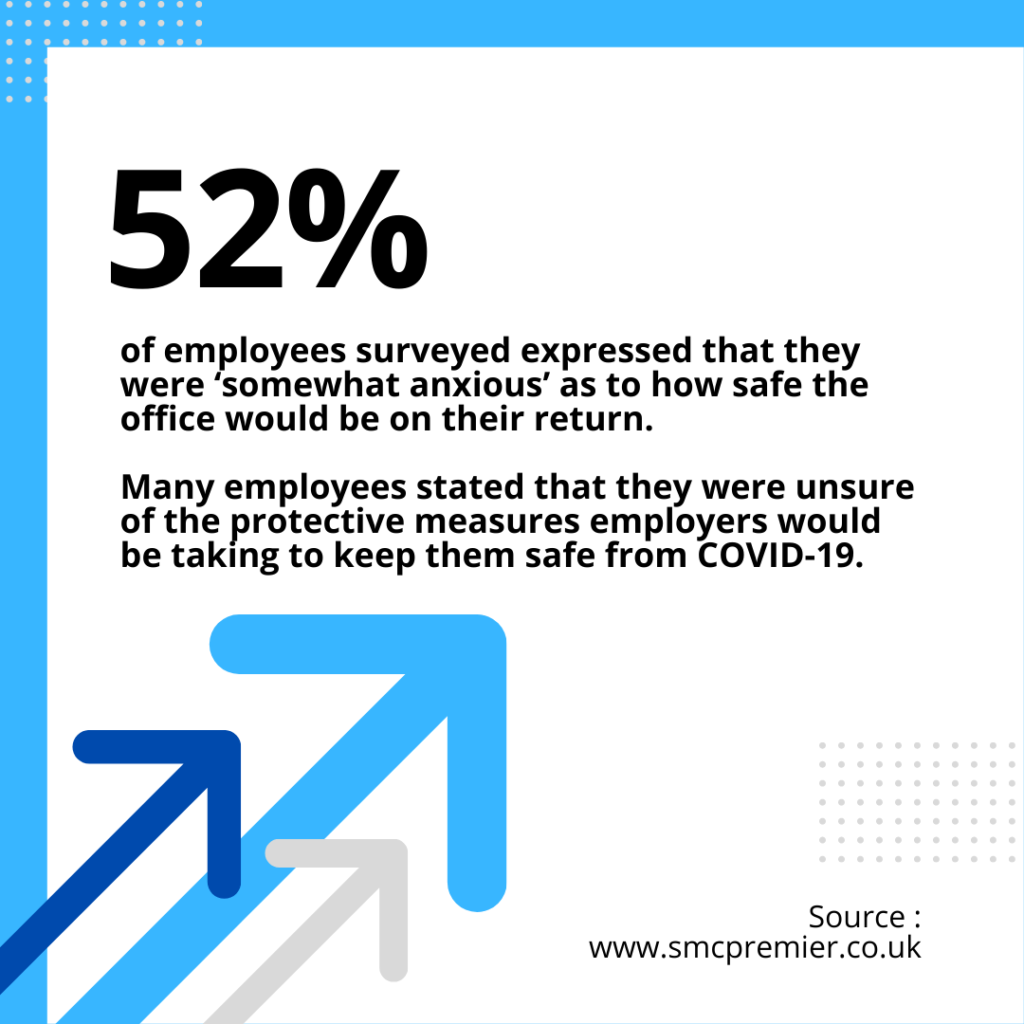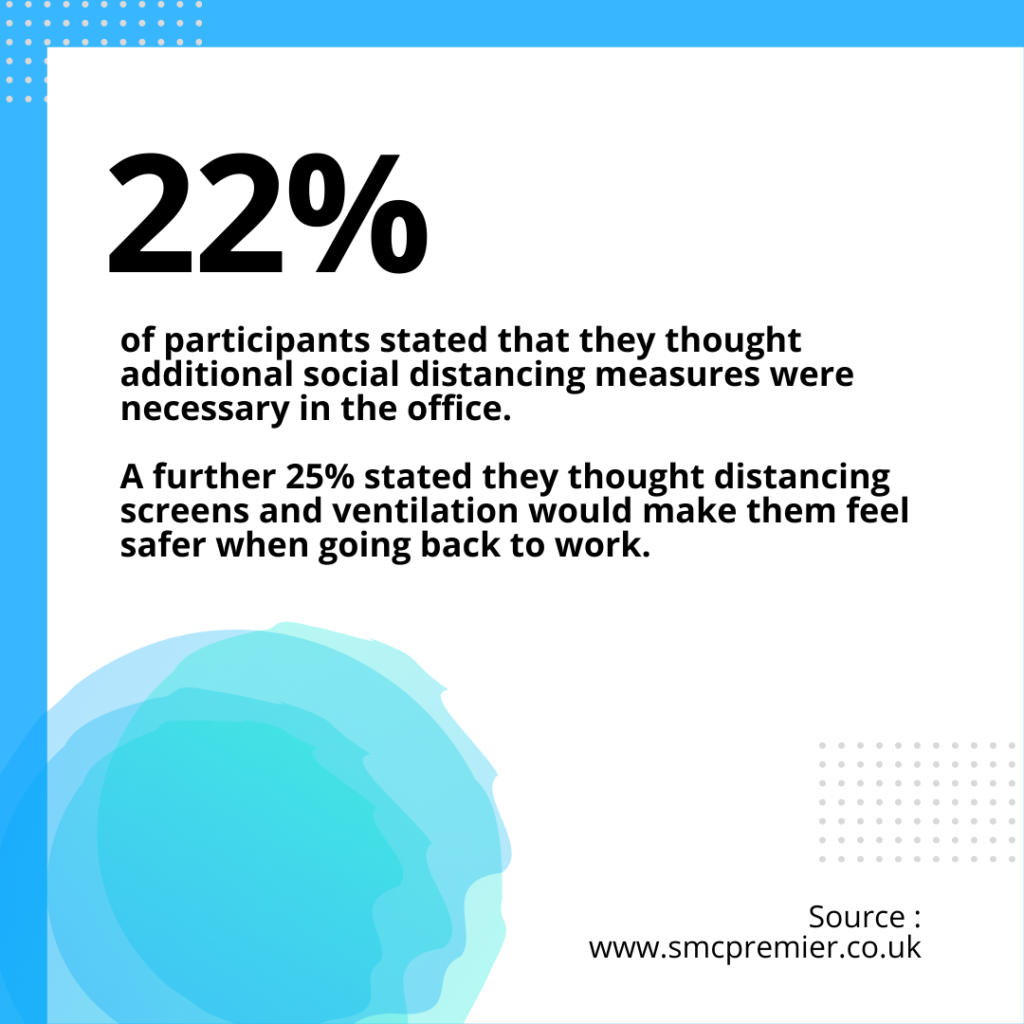The past 18 months of pandemic life have resulted in a record number of people working from home; in many cases, entire companies closed their offices due to the elevated health risks of people being in a shared space.
Now that more and more people are fully vaccinated, and health risks are starting to stabilise, offices are reopening, with employees being called back to their old workplace.
However, during those 18 months, employee opinions on hygiene and safety have changed dramatically, with many anxieties and concerns present about what the future holds.
We decided to conduct a survey on those opinions, to help employers make the return to the office as safe and successful as possible.
This data is from an independent survey of 6,000 office workers in the UK who are currently working remotely full-time, and are preparing to either go back into the office part-time or full-time.

A prevalent emotion towards the return to the office among the workforce is anxiety, in a number of forms. A significant 52% expressed that they were ‘somewhat anxious’ as to how safe the office would be on their return; when asked to expand on that response, many employees stated that they were unsure of the protective measures employers would be taking to keep them safe from COVID-19.
What seemed to be a dominant theme wasn’t so much that not enough was being done, but just that they were being kept in the dark.
With employees who responded with an affirmation to the statement ‘my employee has laid out a clear hygiene plan’, those who were ‘somewhat anxious’ around hygiene and Coronavirus safety dropped to 29%. This shows that no matter what the plan is to tackle hygiene and safety issues, keeping employees in the loop is crucial to alleviating concerns.
Employees don’t necessarily want specific things being done (but more on that later), they often simply want to know that employers have thought about it and have a plan of action.
Being clear with your employees about how you’ll be keeping them safe will play a key role in them feeling respected and valued, and will increase employee retention rates in the months to come.
Regular updates, in the form of emails or other communications, will be extremely valuable.
For some, the anxiety felt toward returning to the office was extreme; 14% of those surveyed felt that a return to work as normal was inappropriate given that COVID-19 is still a present threat, and of that 14%, a further 8% said that they felt there weren’t any measures that would make them feel entirely comfortable.
While employers can do their best to make the workplace a safe and hygienic environment, it appears that some anxieties understandably run deep.
The past year and a half have been traumatic for some, with many losing loved ones to the virus, and a careful and potentially staggered approach to the return to the office may be necessary in many cases.
Another thing that concerned employees was that they weren’t being listened to. Just 16% of those surveyed stated that they ‘strongly agreed that they had a chance to voice concerns’, with a massive 34% stating that they ‘strongly disagreed’.
While keeping employees in the loop is important, from the data it seems that it mustn’t be a passive process; employees want to make suggestions and ask questions, and without the means of doing this in a meaningful and effective manner, anxieties over hygiene and safety can remain or even grow.
Keeping an open dialogue is important – it doesn’t mean that employers have to meet every demand that employees make, but that they at least need to consider them, and realise the concerns behind those demands.
This may be best enacted through an anonymous form on the company website, or through an HR department ‘back to the office’ scheme.
However it’s done, the survey has shown that two-way engagement is important for employee sense of safety.
In addition to general concerns like being kept in the loop and having meaningful engagement, the employees shared a number of specific requirements, which they believed if met, would make their workplace a safer and more hygienic environment to work in.
Of those surveyed, 60% stated that their preference was that the office would be thoroughly disinfected after each working day.
A very significant 78% thought it was a good idea to have accessible, simple sanitisation stations, with at least disinfectant gels to clean hands.
Very few of those who responded affirmatively to the above stated that they were essential requirements to returning to work; however, even if they didn’t consider it a reason to leave the company immediately, other studies have shown that employees who feel they can bring about meaningful change stay with their companies for longer, and often perform better as well.
A feeling of personal investment in a business makes the desire to perform more than simply a financial incentive, and can lead to the development of more creative approaches to problem solving.

Some employees, in addition to cleaning concerns, felt that other measures would make them feel safe in the return to office.
Of the employees surveyed, 22% stated that they thought additional social distancing measures were necessary in the office, and 25% stated they thought additional distancing screens and ventilation would make them feel safer.
While screens are relatively easy to put in place, ventilation is a little more complex, but still achievable through consultation with appropriate contractors.
What may be trickier is social distancing; if your old premises don’t have the capacity for additional space between desks, then one solution may be to upsize.
However, after the tumultuous turns the past year and a half has taken financially, not many companies will be in a position to facilitate a massive upsizing.
What may be a feasible solution in this case is starting the return to work with a hybrid office-work from home model, where employees come in on alternating days.
This can eventually be phased out when things return to normal, but in the meantime, it may make employees feel safer and more comfortable in the workplace.
 We use cookies on our website to give you the most relevant experience by remembering your preferences and repeat visits. By clicking “Accept”, you consent to the use of ALL the cookies.
We use cookies on our website to give you the most relevant experience by remembering your preferences and repeat visits. By clicking “Accept”, you consent to the use of ALL the cookies.